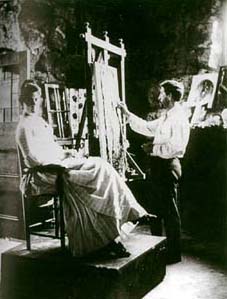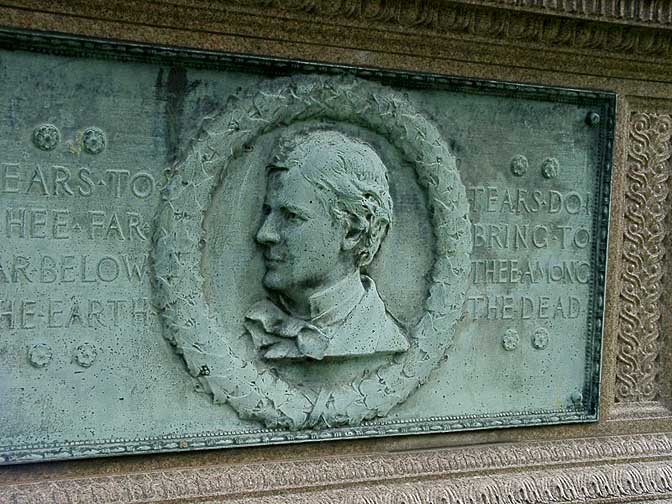![]()
Albright-Knox Art Gallery - Table of Contents ........................... Saint-Gaudens - Table of Contents
Augustus Saint-Gaudens in Buffalo
Illustrations (beneath text) NOT part of the original Spree article
|
Saint-Gaudens and Buffalo Saint-Gaudens (saint-GAWD nz) and Buffalo? What did Augustus Saint-Gaudens (1848-1907) , the greatest American sculptor of the late nineteenth century (or maybe any century), have to do with Buffalo? Many local people and various international art historians know that Saint-Gaudens designed the famous caryatids (columns in human form) , those stately, silent, emotionless classic ladies of uncertain age on the east facade of the Albright-Knox Art Gallery. Some of the same people also know that he did the elegant, cameo-like bas-relief on the Tracy tomb (1888) in Forest Lawn Cemetery But Saint-Gaudens also had other interesting connections with Buffalo. Born in Dublin of an Irish mother and a French father, the red haired Saint-Gaudens, when only six months old was brought to the United States to escape the horrors of the Irish potato famine of 1848. (The forebears of many local Irish families came to buffalo at about the same time.) Later, while apprenticed to a cameo-cutter in New York, Saint-Gaudens studied drawing and sculpture in his meager amount of spare time. His father, a shoemaker, and his cameo-cutter mentor scraped together money to send him to France. There Saint-Gaudens supported himself as a cameo-cutter while he studied sculpture, first privately, then as a student at the famous Ecole des Beaux Arts. While in Paris the young sculptor met the prominent Buffalo physician, Dr., Walter Cary, and his family. Here is how biographer John H. Dryfhout gives the context of the meeting in his fascinating overview, "The Works of Augustus Saint-Gaudens" (University press of New England, 1982): Dr., Walter Cary (1818-1881), born in Batavia, New York, was the only child of Trumbull Cary, an agent of the Holland Land Company, and Margaret Eleanor Brisbane. Dr. Cary attended Union College and the University of Pennsylvania Medical School .... In 1848 Cary married Julia Love, the daughter of Judge Thomas Cutting Love. The Cary family (six sons and one daughter) and Mrs. Cary's sisters, Maria and Elizabeth, went abroad in 1867 and stayed in Europe for nearly a year .... It was on one of these trips (to Europe), on which they took their own stagecoach and six horses, that they met Saint-Gaudens. Dr. Cary died in 1881 at Marseilles, France. In Paris in 1878 Saint-Gaudens apparently executed three
fine, small (approx. 9 1/2 x 6 1/2 inches) bas-reliefs of the bearded, patriarchal
Dr. Cary, head-and shoulders views facing right, and very much alike, except
that in one he is wearing a soft felt hat, and in the other two he is not. One version
is in the fabulous Saint-Gaudens National Shrine at Cornish, New Hampshire; the others
are in private collections. The following year, also in Paris, Saint-Gaudens did a similar-sized, facing right, low relief of Dr. Cary's sister, Maria Maltby Love (1830-1931). Who founded the celebrated Buffalo charitable trust [See Maria Love and Her Crèche] that bears her name. She, her sisters and others in the Cary household made their home (now demolished) at the corner of Delaware and Cary Place a station in the Underground Railway assisting fugitive slaves in reaching Canada. Two other somewhat larger, Saint-Gaudens low reliefs that have Buffalo reference are the one of the twenty-five year old Buffalo native, Frances Folsom (Mrs. Grover) Cleveland (1887) in possession of the Cleveland family, and the one on the Tracy tomb in Forest Lawn. The handsome Mrs. Cleveland, not long out of Wells College in Aurora, New York, sat for Saint-Gaudens at Mrs. Richard Watson Gilder's studio at Buzzard's Bay, near Marion, Connecticut, where the Clevelands summered in the early years of their marriage. The famed architect Stanford White, who frequently collaborated with Saint-Gaudens on monuments, had designed the Tracy sarcophagus. The relief was probably done in Saint-Gaudens's New York City or Cornish studio from the photographs supplied by the Tracys. The Pan Am The show was mounted in the "temporary" brick Fine Arts Building designed by Green and Wicks, and hurriedly constructed when it was known that the Albright Gallery, because of delays in marble shipment, could not be ready in time. The Fine Arts Building stood between Nottingham and the present Scajaquada Parkway, right where the McMillan tennis courts lie. Sherman Monument Saint-Gaudens's first known trip to Buffalo occurred when he was invited to supervise the placing of the Sherman monument. He is described at the site in "Reminiscences of Augustus Saint-Gaudens" (1913), Vol. II, edited and amplified by his son Homer, who quotes a letter from the Art Director of the Pan-Am, William A. Coffin, art critic of the New York Sun and various periodicals, and an established landscape painter in his own right. Said Coffin: To make a long story short, I got both the "Sherman"
and the "Shaw" and other important works by Saint-Gaudens, including
the "Stevenson." As an assistant in placing and setting up the sculpture,
the actual work, I had the capable services of Mr. Henry Hering. My letters
to Saint-Gaudens through it all were many and long. I felt I could not give myself
too much trouble. I determined to have the "Sherman" set up in a fine emplacement
in front of the Fine Arts Building and to have it face the building, the way I was
sure it would look best, the light or the place of the sun would be for the greater
part of the day behind it. If placed with its back to the building, the way Saint-Gaudens
preferred to set his statues - face to the south-- it would look out over
the lake. The emplacement was on a high bank of the lake - an open open space,
macadamized, and we had got the Buffalo Park Department to take away a fountain that
stood there in order to put the pedestal on the same spot. A pedestal was built and
Hering and his men with many days of labor set up the "Sherman." I wrote
Saint-Gaudens again and he came to Buffalo. He looked at the "Sherman"
in the morning, at noon, and in the afternoon. He walked around it again by himself,
and he walked around with Hering. He was greatly pleased altogether. No mistake had
been made, and the effect was grand - that is the word that is the best to
use - and he was content.
Exhibited in the Fine Arts Building were a number of Saint-Gaudens's other works: a bronze portrait bust of Sherman (which had served as a study for the equestrian statue), a plaster cast of the Shaw Memorial, the Robert Louis Stevenson Memorial, the high relief, "Angel with Tablet," and the low relief, "Children of Jacob H. Schiff," as well as two medallions. Shaw Memorial Saint-Gaudens modeled heads of some forty black soldiers to get the handful memorial, which has been called (Time, Jan. 13, 1981), "the most intensely felt image of military commemoration ever made by an American." Robert Louis Stevenson Memorial "Children of Jacob H. Schiff" is now in the Metropolitan Museum of New York. Whether because most of the Saint-Gaudens creations were commissions or loans, or because acquisition money was not available, or because local art gallery officials did not realize their significance, these superb artworks left the city. The Albright Gallery Caryatids
This comment reveals one of Saint-Gaudens's most endearing qualities: his capacity for warm and generous appreciation of the work of other artists. It was toward the end of his life that Saint-Gaudens designed the eight dignified figures for the Albright, each carved from a single block of stone. Six were completed before his death inn 1907. Four of the figures, the ones at each end of the two groups, are the same. The four interior ones represent the four arts: architecture (figure holding a capital), music (holding a lyre), sculpture (holding a niki or winged victory), and painting (holding a palette and brushes). The caryatids were finished in Saint-Gaudens's studio after his death, but not installed until years afterwards. For the opening of the Albright in 1905 two false porticos were constructed and facsimiles of the figures were placed into position. The caryatids were said to have cost Albright $75,000. The decline of the Albright fortunes, along with the death of Saint-Gaudens, were probably responsible for the delay. In 1922 the south group of the real ones, loaned by Mrs. Albright, was installed, while the other real group was stored in her basement. After Albright died in 1931, there was some talk of the estate selling them out of town. However, they were purchased from the Albright estate for $25,000 with local monies from the Forsyth Fund and the Hamilton Ward estate, and the genuine north figures were installed in 1933. Lincoln Memorial Art Historian Kathryn Greenthal of New York's Metropolitan Museum of Art has said, in commenting about Saint-Gaudens's famous standing figure of Lincoln: "Our iconic sense of Abraham Lincoln as statesman, seamed, grave, and erect, was created as much by Saint-Gaudens's bronzes, as by Matthew Brady's photographs." In his works Saint-Gaudens created a remarkable and lasting sense of America and American history. It is nice to know that Buffalo knew a little something of him and a little of his genius. |
Illustrations NOT part of the original Spree article  Saint-Gaudens self-portrait in 1867 Source: Saint-Gaudens National Historical Site  Saint-Gaudens portrait by Will H. Low in 1877 Source: Saint-Gaudens National Historical Site  Saint-Gaudens portrait by Kenyon Cox in 1908 Source: Saint-Gaudens National Historical Site  Saint-Gaudens portrait by Henry Hering in 1908 Source: Saint-Gaudens National Historical Site   4 caryatids representing the Muses at the Albright Knox Art Gallery "In 1905 American sculptor Augustus Saint Gaudens created a caryatid porch for the Albright-Knox Art Gallery in Buffalo, New York in which four of the eight figures (the other four figures holding only wreaths) represented a different art form, Architecture, Painting, Sculpture, and Music" - Wikipedia (September 2012)  Music muse  Dr. Walter Cary Source: Saint-Gaudens National Historical Site  Dr. Walter Cary Source: Saint-Gaudens National Historical Site  Maria Love  Frances Folsom (Mrs. Grover) Cleveland Source: Saint-Gaudens National Historical Site  Frances Folsom (Mrs. Grover) Cleveland Source: Saint-Gaudens National Historical Site  Stanford White Source: McKim, Meade and White  Tracy Sarcophagus  Tracy Sarcophagus  Sherman Monument Source: Saint-Gaudens National Historical Site  Shaw Memorial Source: Saint-Gaudens National Historical Site  Robert Louis Stevenson Memorial Source: Saint-Gaudens National Historical Site  Abraham Lincoln Memorial  Abraham Lincoln Memorial |
